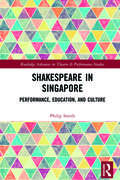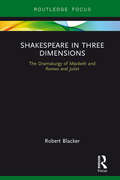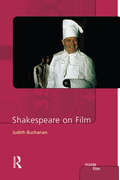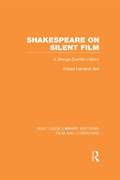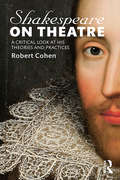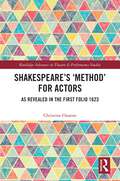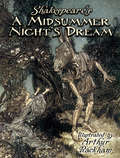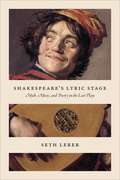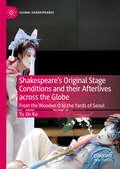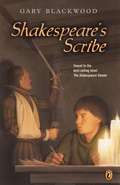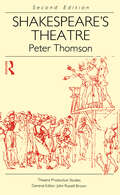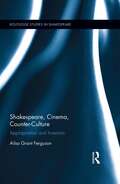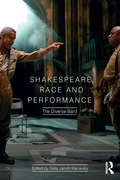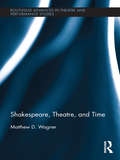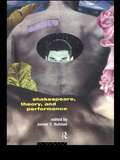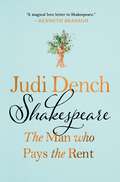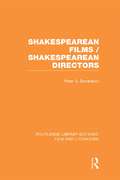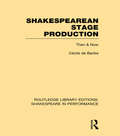- Table View
- List View
Shakespeare in Singapore: Performance, Education, and Culture (Routledge Advances in Theatre & Performance Studies)
by Philip SmithShakespeare in Singapore provides the first detailed and sustained study of the role of Shakespeare in Singaporean theatre, education, and culture. This book tracks the role and development of Shakespeare in education from the founding of modern Singapore to the present day, drawing on sources such as government and school records, the entire span of Singapore's newspaper archives, playbills, interviews with educators and theatre professionals, and existing academic sources. By uniting the critical interest in Singaporean theatre with the substantial body of scholarship that concerns global Shakespeare, the author overs a broad, yet in-depth, exploration of the ways in which Singaporean approaches to Shakespeare have been shaped by, and respond to, cultural work going on elsewhere in Asia. A vital read for all students and scholars of Shakespeare, Shakespeare in Singapore offers a unique examination of the cultural impact of Shakespeare, beyond its usual footing in the Western world.
Shakespeare in Three Dimensions: The Dramaturgy of Macbeth and Romeo and Juliet (Focus on Dramaturgy)
by Robert BlackerIn Shakespeare in Three Dimensions, Robert Blacker asks us to set aside what we think we know about Shakespeare and rediscover his plays on the page, and as Shakespeare intended, in the rehearsal room and in performance. That process includes stripping away false traditions that have obscured his observations about people and social institutions that are still vital to our lives today. This book explores the verities of power and love in Romeo and Juliet and Macbeth, as an example of how to mine the extraordinary detail in all of Shakespeare’s plays, using the knowledge of both theatre practitioners and scholars to excavate and restore them.
Shakespeare on Film
by Judith R. BuchananFrom the earliest days of the cinema to the present, Shakespeare has offered a tempting bank of source material than the film industry has been happy to plunder. Shakespeare on Film deftly examines an extensive range of films that have emerged from the curious union of an iconic dramatist with a medium of mass appeal. The many films Buchanan studies are shown to be telling indicators of trends in Shakespearean performance interpretation, illuminating markers of developments in the film industry and culturally revealing about broader influences in the world beyond the movie theatre. As with other titles from the Inside Film series, the book is illustrated throughout with stills. Each chapter concludes with a list of suggested further reading in the field.
Shakespeare on Screen Othello
by Hatchuel, Sarah and Vienne-Guerrin, Nathalie Sarah Hatchuel Nathalie Vienne-Guerrin"The first volume in the re-launched series Shakespeare on Screen is devoted to Othello, offering up-to-date coverage of recent screen versions as well as new critical essays on older, canonical films. An international cast of authors explores not only productions from the USA and UK, but also translations, adaptations and appropriations in Québec, Italy, India, Brazil and Mexico. The volume takes part in the ceaseless cultural investigation of what Othello says about Shakespeare, the past and our present time, supported by an invaluable film-bibliography. Accompanying free online resources include a fuller version of the bibliography and an additional contribution on YouTube versions of Othello. This book will be a valuable resource for students, scholars and teachers of film studies and Shakespeare studies"--
Shakespeare on Silent Film: A Strange Eventful History (Routledge Library Editions: Film and Literature)
by Robert Hamilton BallIn 1899, when film projection was barely three years old, Herbert Beerbohm Tree was filmed as King John. In his highly entertaining history, Robert Hamilton Ball traces in detail the fate of Shakespeare on silent films from Tree’s first effort until the establishment of sound in 1929. The silent films brought Shakespeare to a wide public who had never had the chance to see his plays in the theatre. And Shakespeare gave the film makers an air of respectability that was badly needed by a medium with a reputation for frivolity. This work, first published in 1968, brings history to life with excerpts from scenarios, from reviews and from contemporary film journals, and with reproduction of stills and frames from the films themselves, including unusual shots of leading screen actors. This is a valuable source book for film experts, enhanced by full notes, bibliography and indexes; a fresh approach for Shakespeareans; and a vivid sketch of a world that has passed for all.
Shakespeare on Theatre: A Critical Look at His Theories and Practices
by Robert CohenIn Shakespeare on Theatre, master acting teacher Robert Cohen brilliantly scrutinises Shakespeare's implicit theories of acting, paying close attention to the plays themselves and providing a wealth of fascinating historical evidence. What he finds will surprise scholars and actors alike – that Shakespeare's drama and his practice as an actor were founded on realism, though one clearly distinct from the realism later found in Stanislavski. Shakespeare on Acting is an extraordinary introduction to the way the plays articulate a profound understanding of performance and reflect the life and times of a uniquely talented theatre-maker.
Shakespeare's 'Method' for Actors: As Revealed in The First Folio 1623 (Routledge Advances in Theatre & Performance Studies)
by Christine OzanneBy using only the First Folio text, this book acts as an original guide to performing Shakespeare’s plays.This book is the accumulation of the many Clues from the First Folio of Shakespeare’s plays (as opposed to any edited version) that help to inform contemporary performances and offers a complete understanding of the text. This study compares the original acting of Shakespeare's plays with the modern method of rehearsing and performing theatre and film productions. It likens today’s screen actors’ limited preparation time for their performances, with the Elizabethan acting company’s restricted conditions for theirs. This book covers in-depth analysis of thirty Clues, some of which have been edited out in modern versions, thereby losing the effect of the useful Clue. Here is a clear and intelligent view of the riches to be mined in the text contained in the 1623 First Folio.New insights into all the plays are given to actors, directors, teachers and people who care about the works of William Shakespeare and it is a companion volume to Patrick Tucker’s Shakespeare’s First Folio Cue Scripts (Routledge 2024).
Shakespeare's A Midsummer Night's Dream
by William Shakespeare Arthur RackhamShakespeare's incomparable romantic comedy takes on a new and vivid life in these brilliant images by one of the 20th century's leading illustrators. The fairy world of A Midsummer Night's Dream is the perfect milieu for the artistry of Arthur Rackham, a popular illustrator of fairy tales who possessed a striking gift for depicting fanciful creatures. His dreamlike visions provide a series of unique portraits from the enchanted wood outside ancient Athena, where Oberon and Titania rule a kingdom of diminutive sprites. <p><p> Rackham's career coincided with the era known as the Golden Age of Illustration, an age that witnessed the rise of increasingly sophisticated color printing techniques. His interpretation of A Midsummer Night's Dream, which first appeared in 1908, received the full benefit of the improved technology, and this faithful reprint offers a quality of printing and sharpness of reproduction that rivals the limited and first editions. The complete text of the play appears here, along with 40 full-color and numerous black-and-white illustrations — a splendid tribute by a master of fantasy art to an immortal play.
Shakespeare's Lyric Stage: Myth, Music, and Poetry in the Last Plays
by Seth LererWhat does it mean to have an emotional response to poetry and music? And, just as important but considered less often, what does it mean not to have such a response? What happens when lyric utterances—which should invite consolation, revelation, and connection—somehow fall short of the listener’s expectations? As Seth Lerer shows in this pioneering book, Shakespeare’s late plays invite us to contemplate that very question, offering up lyric as a displaced and sometimes desperate antidote to situations of duress or powerlessness. Lerer argues that the theme of lyric misalignment running throughout The Tempest, The Winter’s Tale, Henry VIII, and Cymbeline serves a political purpose, a last-ditch effort at transformation for characters and audiences who had lived through witch-hunting, plague, regime change, political conspiracies, and public executions. A deep dive into the relationship between aesthetics and politics, this book also explores what Shakespearean lyric is able to recuperate for these “victims of history” by virtue of its disjointed utterances. To this end, Lerer establishes the concept of mythic lyricism: an estranging use of songs and poetry that functions to recreate the past as present, to empower the mythic dead, and to restore a bit of magic to the commonplaces and commodities of Jacobean England. Reading against the devotion to form and prosody common in Shakespeare scholarship, Lerer’s account of lyric utterance’s vexed role in his late works offers new ways to understand generational distance and cultural change throughout the playwright’s oeuvre.
Shakespeare's Original Stage Conditions and their Afterlives across the Globe: From the Wooden O to the Yards of Seoul (Global Shakespeares)
by Yu Jin KoThis book brings together two separate fields by combining a study of Shakespeare's original stage conditions with an exploration of his plays in performance across the globe. The book contributes new insights into how early-modern stage conditions shaped the writing, production, and reception of Shakespeare's plays, but takes the further step of examining how original stage conditions re-emerge, not only in Globe replicas like the London Globe, but in unexpected and sometimes unconscious reconfigurations in adaptations and productions from around the world: film versions of Othello from Mexico to India that take dancing cues and anxieties about dance from the play and centralize dance; Korean adaptations for the madang (or yard) that reimagine Shakespeare's theatrical spaces and their relationships to audiences; Noh re-imaginings on film and onstage that foreground the theatrical; a teen film remake of Othello that raises questions about how blackness is figured today and on Shakespeare's stage, among others. By studying original stage conditions and their global afterlives, the book illuminates how global productions negotiate historical and cultural differences and thereby, paradoxically, engage with the cultural specificities of the present.
Shakespeare's Scribe
by Gary BlackwoodWhen an outbreak of the deadly Black Plague closes the Globe Theatre, William Shakespeare's acting troupe sets off on a tour of England. Widge, the orphan-turned-actor, knows that he'll be useful on the trip. Not only does he love the stage, but his knack for a unique shorthand has proven him one of the most valuable apprentices in the troupe. But then a mysterious man appears, claiming to know a secret from Widge's past-a secret that may forever force him from the theatre he loves. "An exciting, well-written tale that is sure to leave [readers] clamoring for more. " (School Library Journal, starred review) .
Shakespeare's Storytelling: An Introduction to Genre, Character, and Technique
by Nate EastmanShakespeare’s Storytelling: An Introduction to Genre, Character, and Technique is a textbook focused on specific storytelling techniques and genres that Shakespeare invented or refined. Drawing on examples from popular novels, plays, and films (such as IT, Beloved, Sex and the City, The Godfather, and Fences) the book provides an overview of how Shakespearean storytelling techniques including character flaws, conflicts, symbols, and more have been adapted by later writers and used in the modern canon. Rather than taking a historicist or theoretical approach, Nate Eastman uses recognizable references and engaging language to teach the concepts and techniques most applicable to the future study of Creative Writing, English, Theater, and Film and Media. Students will be prepared to interpret Shakespeare’s plays and understand Shakespeare as the beginning of a literary tradition. A readable introduction to Shakespeare and his significance, this book is suitable for undergraduates.
Shakespeare's Theatre (Theatre Production Studies)
by Peter ThomsonReviews of the First Edition `...valuable and enjoyable reading for all studying Shakespeare's plays.' Following in the patternestablished by John Russell Brown for the excellent series (Theatre and Production Studies), he provides first an account of Shakespeare's company, then a study of three individual plays Twelfth Night, Hamlet and Macbeth as performed by the company. Peter Thomson writes in a crisp, sharp, enlivening style.' TLS '`...the best analysis yet of Elizabethan acting practices, excavated form the texts themselves rather than reconstructed on basis of one monolithic theory, and an essay on Hamlet that is a model of Critical intelligence and theatrical invention.' Yearbook of English Studies `Synthesizes the important facts and summarizes projects with a vigorous prose style, and expertly applies his experience in both practical drama and academic teaching to his discussion.' Review of English Studies
Shakespeare, Cinema, Counter-Culture: Appropriation and Inversion (Routledge Studies in Shakespeare #17)
by Ailsa Grant FergusonAddressing for the first time Shakespeare’s place in counter-cultural cinema, this book examines and theorizes counter-hegemonic, postmodern, and post-punk Shakespeare in late 20th and early 21st century film. Drawing on a diverse range of case studies, Grant Ferguson presents an interdisciplinary approach that offers new theories on the nature and application of Shakespearean appropriations in the light of postmodern modes of representation. The book considers the nature of the Shakespearean inter-text in subcultural political contexts concerning the politicized aesthetics of a Shakespearean ‘body in pieces,’ the carnivalesque, and notions of Shakespeare as counter-hegemonic weapon or source of empowerment. Representative films use Shakespeare (and his accompanying cultural capital) to challenge notions of capitalist globalization, dominant socio-cultural ideologies, and hegemonic modes of expression. In response to a post-modern culture saturated with logos and semiotic abbreviations, many such films play with the emblematic imagery and references of Shakespeare’s texts. These curious appropriations have much to reveal about the elusive nature of intertextuality in late postmodern culture and the battle for cultural ownership of Shakespeare. As there has yet to be a study that isolates and theorizes modes of Shakespearean production that specifically demonstrate resistance to the social, political, ideological, aesthetic, and cinematic norms of the Western world, this book expands the dialogue around such texts and interprets their patterns of appropriation, adaptation, and representation of Shakespeare.
Shakespeare, Performance and the Archive
by Barbara HodgdonShakespeare, Performance and the Archive is a ground-breaking and movingly written exploration of what remains when actors evacuate the space and time of performance. An analysis of ‘leftovers’, it moves between tracking the politics of what is consciously archived and the politics of visible and invisible theatrical labour to trace the persistence of performance. In this fascinating volume, Hodgdon considers how documents, material objects, sketches, drawings and photographs explore scenarios of action and behaviour – and embodied practices. Rather than viewing these leftovers as indexical signs of a theatrical past, Hodgdon argues that the work they do is neither strictly archival nor documentary but performative – that is, they serve as sites of re-performance. Shakespeare, Performance and the Archive creates a deeply materialized historiography of performance and attempts to make that history do something entirely new. Barbara Hodgdon is Professor of English at the University of Michigan, now retired. Her major interest is in theatrical performances, especially performed Shakespeare. She is the author of: The End Crowns All, The Shakespeare Trade, and most recently the Arden edition of The Taming of the Shrew.
Shakespeare, Race and Performance: The Diverse Bard
by Delia Jarrett-MacauleyWhat does it mean to study Shakespeare within a multicultural society? And who has the power to transform Shakespeare? The Diverse Bard explores how Shakespeare has been adapted by artists born on the margins of the Empire, and how actors of Asian and African-Caribbean origin are being cast by white mainstream directors. It examines how notions of 'race' define the contemporary British experience, including the demands of traditional theatre, and it looks at both the playtexts themselves and contemporary productions. Editor Delia Jarrett-Macauley assembles a stunning collection of classic texts and new scholarship by leading critics and practitioners, to provide the first comprehensive critical and practical analysis of this field.
Shakespeare, The Movie II: Popularizing the Plays on Film, TV, Video and DVD
by Richard Burt Lynda E. BooseFollowing on from the phenomenally successful Shakespeare, The Movie, this volume brings together an invaluable new collection of essays on cinematic Shakespeares in the 1990s and beyond. Shakespeare, The Movie II:*focuses for the first time on the impact of postcolonialism, globalization and digital film on recent adaptations of Shakespeare;*takes in not only American and British films but also adaptations of Shakespeare in Europe and in the Asian diapora;*explores a wide range of film, television, video and DVD adaptations from Almereyda's Hamlet to animated tales, via Baz Luhrmann, Kenneth Branagh, and 1990s' Macbeths, to name but a few;*offers fresh insight into the issues surrounding Shakespeare on film, such as the interplay between originals and adaptations, the appropriations of popular culture, the question of spectatorship, and the impact of popularization on the canonical status of "the Bard."Combining three key essays from the earlier collection with exciting new work from leading contributors, Shakespeare, The Movie II offers sixteen fascinating essays. It is quite simply a must-read for any student of Shakespeare, film, media or cultural studies.
Shakespeare, Theatre, and Time (Routledge Advances in Theatre & Performance Studies #20)
by Matthew WagnerThat Shakespeare thematized time thoroughly, almost obsessively, in his plays is well established: time is, among other things, a 'devourer' (Love's Labour's Lost), one who can untie knots (Twelfth Night), or, perhaps most famously, simply ‘out of joint’ (Hamlet). Yet most critical commentary on time and Shakespeare tends to incorporate little focus on time as an essential - if elusive - element of stage praxis. This book aims to fill that gap; Wagner's focus is specifically performative, asking after time as a stage phenomenon rather than a literary theme or poetic metaphor. His primary approach is phenomenological, as the book aims to describe how time operates on Shakespearean stages. Through philosophical, historiographical, dramaturgical, and performative perspectives, Wagner examines the ways in which theatrical activity generates a manifest presence of time, and he demonstrates Shakespeare’s acute awareness and manipulation of this phenomenon. Underpinning these investigations is the argument that theatrical time, and especially Shakespearean time, is rooted in temporal conflict and ‘thickness’ (the heightened sense of the present moment bearing the weight of both the past and the future). Throughout the book, Wagner traces the ways in which time transcends thematic and metaphorical functions, and forms an essential part of Shakespearean stage praxis.
Shakespeare, Theory and Performance
by James C. BulmanShakespeare, Theory and Performance is a groundbreaking collection of seminal essays which apply the abstract theory of Shakespearean criticism to the practicalities of performance. Bringing together the key names from both realms, the collection reflects a wide range of sources and influences, from traditional literary, performance and historical criticism to modern cultural theory. Together they raise questions about the place of performance criticism in modern and often competing debates of cultural materialism, new historicism, feminism and deconstruction. An exciting and fascinating volume, it will be important reading for students and scholars of literary and theatre studies alike.
Shakespeare, or, The Man Who Pays the Rent
by Judi Dench Brendan O'HeaTaking a curtain call with a live snake in her wig... Cavorting naked through the Warwickshire countryside painted green... <P> Acting opposite a child with a pumpkin on his head... <P> These are just a few of the things Dame Judi Dench has done in the name of Shakespeare. <P><P> For the very first time, Judi opens up about every Shakespearean role she has played throughout her seven-decade career, from Lady Macbeth and Titania to Ophelia and Cleopatra. In a series of intimate conversations with actor & director Brendan O'Hea, she guides us through Shakespeare's plays with incisive clarity, revealing the secrets of her rehearsal process and inviting us to share in her triumphs, disasters, and backstage shenanigans. <P><P> Interspersed with vignettes on audiences, critics, company spirit and rehearsal room etiquette, she serves up priceless revelations on everything from the craft of speaking in verse to her personal interpretations of some of Shakespeare's most famous scenes, all brightened by her mischievous sense of humour, striking level of honesty and a peppering of hilarious anecdotes, many of which have remained under lock and key until now. <P><P> Instructive and witty, provocative and inspiring, this is ultimately Judi's love letter to Shakespeare, or rather, The Man Who Pays The Rent. <p> <b>New York Times Bestseller</b>
Shakespeare: The Bard's Guide to Abuses and Affronts (RP Minis)
by Edited by Nancy ArmstrongPresenting a most civilized way to silence boors, deflect rudeness, and chide churlish lovers: Our mini book of insults culled from the dramatic works of English literature's most gifted wordsmith. Shakespeare's enduring putdowns include "Thou art a very ragged Wart" (Henry IV), "Thy kiss is as comfortless as frozen water to a starved snake" (Troilus and Cressida), and "In civility thou seem'st so empty" (As You Like It). Why resort to vulgarity when a high-brow literary epithet does the job so well?
Shakespearean Adaptation, Race and Memory in the New World (Palgrave Shakespeare Studies)
by Joyce Green MacDonaldAs readers head into the second fifty years of the modern critical study of blackness and black characters in Renaissance drama, it has become a critical commonplace to note black female characters’ almost complete absence from Shakespeare’s plays. Despite this physical absence, however, they still play central symbolic roles in articulating definitions of love, beauty, chastity, femininity, and civic and social standing, invoked as the opposite and foil of women who are “fair”. Beginning from this recognition of black women’s simultaneous physical absence and imaginative presence, this book argues that modern Shakespearean adaptation is a primary means for materializing black women’s often elusive presence in the plays, serving as a vital staging place for historical and political inquiry into racial formation in Shakespeare’s world, and our own. Ranging geographically across North America and the Caribbean, and including film and fiction as well as drama as it discusses remade versions of Othello, Romeo and Juliet, Antony and Cleopatra, and The Taming of the Shrew, Shakespearean Adaptation, Race, and Memory in the New World will attract scholars of early modern race studies, gender and performance, and women in Renaissance drama.
Shakespearean Celebrity in the Digital Age: Fan Cultures and Remediation (Palgrave Studies in Adaptation and Visual Culture)
by Anna BlackwellThis book offers a timely examination of the relationship between Shakespeare and contemporary digital media. By focusing upon a variety of ‘Shakespearean’ individuals, groups and communities and their ‘online’ presence, the book explores the role of popular internet culture in the ongoing adaptation of Shakespeare’s plays and his general cultural standing. The description of certain performers as ‘Shakespearean’ is a ubiquitous but often throwaway assessment. However, a study of ‘Shakespearean’ actors within a broader cultural context reveals much, not only about the mutable face of British culture (popular and ‘highbrow’) but also about national identity and commerce. These performers share an online space with the other major focus of the book: the fans and digital content creators whose engagement with the Shakespearean marks them out as more than just audiences and consumers; they become producers and critics. Ultimately, Digital Shakespeareans moves beyond the theatrical history focus of related works to consider the role of digital culture and technology in shaping Shakespeare’s contemporary adaptive legacy and the means by which we engage with it.
Shakespearean Films/Shakespearean Directors (Routledge Library Editions: Film and Literature)
by Peter S. DonaldsonOriginally published in 1990, this book brought a new rigor and subtlety to the interpretation of film adaptations of Shakespeare. Drawing on traditional literary analysis, psychoanalysis, and current film theory about gender and subjectivity, the author combines close readings of seven films with historical and biographical studies of the directors who made them. Offering substantial readings of Jean-Luc Godard’s controversial deconstructed King Lear and of Liz White’s independent African-American Othello, Donaldson also applies his provocative and contemporary point of view to more familiar films. He reads Olivier’s Henry V in relation to its treatment of sexual difference; Olivier’s Hamlet in part as an expression of the director’s childhood sexual trauma; Kurosawa’s Throne of Blood as an allegory of the relationship between Western and Japanese cinema; and Zeffirelli’s immensely popular Romeo and Juliet in the light of its powerful homoerotic subtext. With striking perspectives on Shakespeare, on the movies as an expressive medium, and on the complex processes of cultural change, this is timeless useful reading for teachers and students of film and literature.
Shakespearean Stage Production: Then and Now (Routledge Library Editions: Shakespeare in Performance #3)
by Cécile De BankeAn absorbing and original addition to Shakespeareana, this handbook of production is for all lovers of Shakespeare whether producer, player, scholar or spectator. In four sections, Staging, Actors and Acting, Costume, Music and Dance, it traces Shakespearean production from Elizabethan times to the 1950s when the book was originally published. This book suggests that Shakespeare should be performed today on the type of stage for which his plays were written. It analyses the development of the Elizabethan stage, from crude inn-yard performances to the building and use of the famous Globe. Since the Globe saw the enactment of some of the Bard’s greatest dramas, its construction, properties, stage devices, and sound effects are reviewed in detail with suggestions on how a producer can create the same effects on a modern or reconstructed Elizabethan stage. Shakespeare’s plays were written to fit particular groups of actors. The book gives descriptions of the men who formed the acting companies of Elizabethan London and of the actors of Shakespeare’s own company, giving insights into the training and acting that Shakespeare advocated. With full descriptions and pages of reproductions, the costume section shows the types of dress necessary for each play, along with accessories and trimmings. A table of Elizabethan fabrics and colours is included. The final section explores the little-known and interesting story of the integral part of music and dance in Shakespeare’s works. Scene by scene the section discusses appropriate music or song for each play and supplies substitute ideas for Elizabethan instruments. Various dances are described – among them the pavan, gailliard, canary and courante. This book is an invaluable wealth of research, with extensive bibliographies and extra information.
